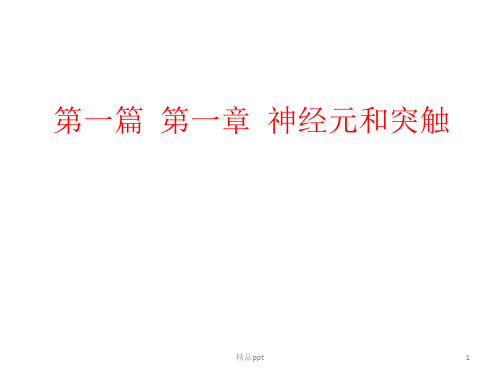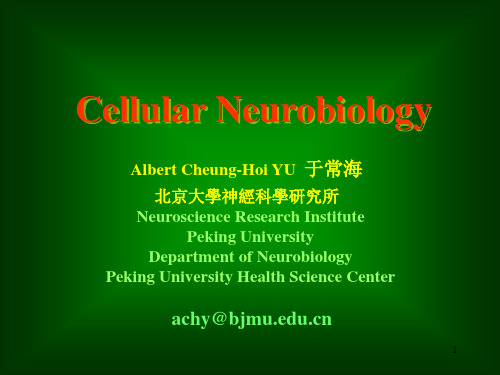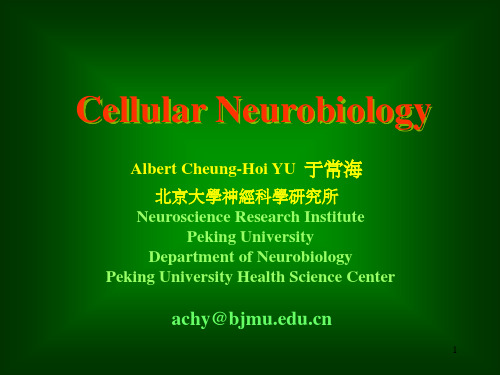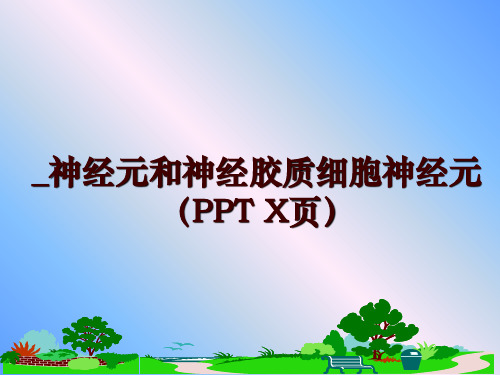北大神经生物学课件2神经元和神经胶质细胞神经元
合集下载
神经元与神经胶质细胞ppt课件

精品ppt
28
朗飞氏结(Ranvier node)
少突胶质细胞与中枢有髓神经纤维
关系模式图
精品ppt
29
ቤተ መጻሕፍቲ ባይዱ
HE染色,高倍
*郎飞氏结
精品ppt
30
有髓神经纤维的横切面
精品ppt
31
有髓神经纤维电镜像 ×39000
精品ppt
32
⑤神经纤维的功能是传导兴奋,传导速度与神经纤维的 直径有关,即神经纤维直径越大,则传导速度越快。
分类:星形胶质细胞、少突胶质细胞、小胶质 细胞
功能: (1)支持作用 (2)修复和再生作用 (3)物质代谢和营养性作用 (4)绝缘和屏障作用 (5)维持合适的离子浓度 (6)摄取和分泌神经递质
精品ppt
44
中枢神经系统胶质细胞显微照片 镀银染色 高倍
左图:A.纤维性星形胶质细胞 B. 原浆性星形胶质细胞
精品ppt
19
树突的特征
①树突是胞体向外发出的树状突起,其内容物 和胞体大致相同,可将树突看作胞体的延续。
②树突起始较宽,反复分支,不断变细,长短 不一,通常短于轴突。
③树突内的细胞器随其分支变细而减少,甚至 消失。
④树突一般没有髓鞘。
精品ppt
20
精品ppt
21
⑤ 树突棘(dendritic spine)。一般认为树突棘是与其 它传入神经元形成突触的部位。
精品ppt
15
线粒体:细胞呼吸的场所,能量工厂
精品ppt
16
微管蛋白
微管
神经丝
微丝
细胞骨架的构成
精品ppt
17
细胞核
细胞核呈球型,由核膜包围 核内含有遗传物质DNA 基因表达的过程
北大神经生物学2神经元和神经胶质细胞-神经元(课堂PPT)

– myelin sheath
9
Differences between Axons and Dendrites
Axons
Dendrites
Take information away from the cell body
Take information to the cell body
Smooth surface
Nucleus Nucleolus Microfilaments/Neuro
tubules
Endoplasmic Reticulum (ER) Mitochondria Golgi Apparatus
Nissl Bodies
Others
8
Axon and Dendrites
• Dendrites :
Axon Hillock
(Axonal end feet)
5
The Axon and Axon Collaterals
6
Neurons
Structure & Function
• Cell Body (Soma): Life Support
– Protein Synthesis – Single Nucleus, RER (Nissl Bodies)
2
Cellular Components
• Neurons: Excitable cells – “wiring” “Signal Senders”
• Neuroglia: Supportห้องสมุดไป่ตู้ Nurturing, Insulation
3
Nerve Cells
Neurons
Neur4oglia
Structure of Neurons
9
Differences between Axons and Dendrites
Axons
Dendrites
Take information away from the cell body
Take information to the cell body
Smooth surface
Nucleus Nucleolus Microfilaments/Neuro
tubules
Endoplasmic Reticulum (ER) Mitochondria Golgi Apparatus
Nissl Bodies
Others
8
Axon and Dendrites
• Dendrites :
Axon Hillock
(Axonal end feet)
5
The Axon and Axon Collaterals
6
Neurons
Structure & Function
• Cell Body (Soma): Life Support
– Protein Synthesis – Single Nucleus, RER (Nissl Bodies)
2
Cellular Components
• Neurons: Excitable cells – “wiring” “Signal Senders”
• Neuroglia: Supportห้องสมุดไป่ตู้ Nurturing, Insulation
3
Nerve Cells
Neurons
Neur4oglia
Structure of Neurons
神经元和神经胶质细胞2.ppt

• 中枢神经系统的无髓神经纤维 裸露的轴突,借星型胶质细胞分隔 神经内膜 神经束膜 神经外膜
二、神经元的分类
突起数
单极 双极 多极
功能
感觉 中间 运动
兴奋性 作 用 抑制性
递质
5-HT NE DA Ach …….
三、神经元的骨架
• 微管 • 微丝 • 神经丝
(一)微管(Microtubule)
神经元与胶质细胞
神经再生重点实验室 沈爱国
第一节 神经元
• 人脑大约有1011亿个神经元 • 大小, 形状各异
一、神经元的一般结构
• 1、胞体 2、突起:树突
轴突 3、终末
输入信号 整合信号
传导信号
输出信号
一、1、细胞胞体体
细胞膜
细胞核:Bar小体
细胞质 细胞器
尼氏小体 神经原纤维
细胞膜:液态脂质双分子层,其间镶嵌有 一些蛋白质
中间丝蛋白的类型与分布
四、神经元的胞浆运输-轴突转运
• 顺向转运和逆向转运 • 慢速转运和快速转运
轴突转运的主要 通过驱动蛋白的作 用,由ATP提供能 量,沿微管自胞体 向末梢运行
运动蛋白的再循环
第二节 神经胶质细胞
大胶质细胞
中枢胶质细胞
星形胶质细胞 (astrocyte) 少突胶质细胞(oligodendrocyte)
• C:巨噬细胞 • D:损伤变性的神
经细胞
其它类型的胶质细胞
• 室管膜细胞
脉络丛上皮细胞
小 结(1)
• 神经系统由神经元和神经胶质细胞构成。 • 神经元由胞体、突起(树突、轴突)、终
末构成。胞体是神经元的营养代谢和功能 活动中心;树突接受刺激,轴突将胞体发 出的冲动向其它神经元或效应器传递。 • 神经纤维包括有髓和无髓两种。有髓纤维 传导速度快于无髓纤维
二、神经元的分类
突起数
单极 双极 多极
功能
感觉 中间 运动
兴奋性 作 用 抑制性
递质
5-HT NE DA Ach …….
三、神经元的骨架
• 微管 • 微丝 • 神经丝
(一)微管(Microtubule)
神经元与胶质细胞
神经再生重点实验室 沈爱国
第一节 神经元
• 人脑大约有1011亿个神经元 • 大小, 形状各异
一、神经元的一般结构
• 1、胞体 2、突起:树突
轴突 3、终末
输入信号 整合信号
传导信号
输出信号
一、1、细胞胞体体
细胞膜
细胞核:Bar小体
细胞质 细胞器
尼氏小体 神经原纤维
细胞膜:液态脂质双分子层,其间镶嵌有 一些蛋白质
中间丝蛋白的类型与分布
四、神经元的胞浆运输-轴突转运
• 顺向转运和逆向转运 • 慢速转运和快速转运
轴突转运的主要 通过驱动蛋白的作 用,由ATP提供能 量,沿微管自胞体 向末梢运行
运动蛋白的再循环
第二节 神经胶质细胞
大胶质细胞
中枢胶质细胞
星形胶质细胞 (astrocyte) 少突胶质细胞(oligodendrocyte)
• C:巨噬细胞 • D:损伤变性的神
经细胞
其它类型的胶质细胞
• 室管膜细胞
脉络丛上皮细胞
小 结(1)
• 神经系统由神经元和神经胶质细胞构成。 • 神经元由胞体、突起(树突、轴突)、终
末构成。胞体是神经元的营养代谢和功能 活动中心;树突接受刺激,轴突将胞体发 出的冲动向其它神经元或效应器传递。 • 神经纤维包括有髓和无髓两种。有髓纤维 传导速度快于无髓纤维
生物学2神经元和神经胶质细胞-神经元(课堂PPT)

• Axon: Longest process transmits messages
away from cell body
• Dendrites: Multiple processes off cell
body – receive messages
7
What are inside of a neuron?
– dendrite tree
• Axon :
– axon hillock (axon origination) – axonal transport system – initial segment (first myelin sheath)
• action potential generation
branches)
–Sensory afferent neurons (dorsal root ganglia)
11
Classification of Neurons by Morphology
12
Classification of Neurons by Axon Length
1. Golgi type I Neurons • Long axons (longest from the cortex to the tip of spinal cord, 50-70 cm)
neuron and interneuron)
•Bipolar: “bi-” 2 processes
–Found in some sensory organs (retina, taste,
smell, inner ear neuron)
•Unipolar (pseudo-unipolar): “uni -” 1 process (with
away from cell body
• Dendrites: Multiple processes off cell
body – receive messages
7
What are inside of a neuron?
– dendrite tree
• Axon :
– axon hillock (axon origination) – axonal transport system – initial segment (first myelin sheath)
• action potential generation
branches)
–Sensory afferent neurons (dorsal root ganglia)
11
Classification of Neurons by Morphology
12
Classification of Neurons by Axon Length
1. Golgi type I Neurons • Long axons (longest from the cortex to the tip of spinal cord, 50-70 cm)
neuron and interneuron)
•Bipolar: “bi-” 2 processes
–Found in some sensory organs (retina, taste,
smell, inner ear neuron)
•Unipolar (pseudo-unipolar): “uni -” 1 process (with
神经生物学神经元与胶质细胞课件.ppt

神经元分类
❖ 按突起数目分类
➢ 多极神经元,神经元有一个 轴突和多个树突,如脊髓的 运动神经元
➢ 双极神经元,神经元有两个 突起,一个是树突,另一个 是轴突,例如视网膜的双极 神经元
➢ (假)单极神经元,从胞体发出 一个突起,距胞体不远又以T形 分为两支,一支分布到外周的其 他组织器官,称为周围突;另一 支进入中枢神经系统,称为中枢 突,如背根神经节中的细胞。 (假)单极神经元的两个分支, 按神经冲动的传导方向,中枢相 当于轴突,周围突相当于树突。
影响化学性突触传递的因素
❖ 细胞外Ca2+浓度升高或 Mg2+浓度降低能使递质释放 增多。
❖新斯的明、有机磷农药等可抑制胆碱酯酶,使乙酰 胆碱持续发挥作用,从而影响相应的突触传递。
❖ 筒 箭 毒 碱 可 特 异 地 阻 断 骨 骼 肌 终 板 膜 上 的 Ach 受 体 通道,使神经-肌接头的传递受阻,肌肉松弛。
❖ 中间神经元间,辐散与聚 合式联系同时存在可形成 链锁式或环式联系。
❖ 链锁式联系→扩大其作用 范围。
❖ 兴奋冲动通过环式联系, 可因负反馈而使活动及时 终止,或因正反馈而使兴 奋增强和延续。后发放
2.2 胶质细胞
❖数量:1-5×1012,为神经元数量的10~50倍。 ❖种类:在周围神经系统,有施万细胞和卫星
细胞;在中枢神经系统,有星形胶质细胞, 少突胶质细胞,小胶质细胞。
❖ 生理特性: ❖ 无树突轴突之分,无化学性突触,无动作电位。 ❖ 细胞间由低电阻缝隙连接。 ① 分裂增殖能力强。
神经胶质细胞的功能
❖ 支持和引导神经元迁移:中枢内除神经元和血管外,其 余由星形胶质细胞充填,起支持神经元胞体和纤维的作 用。
② 逆向轴浆运输
最新北大神经生物学课件2_2-2神经元和神经胶质细胞-胶质细胞-药学医学精品资料

Three Types of Metabolic Cooperation of Astrocytes and Neurons
1. Supply of the energy substrate lactate to neurons 2. The recycling of neuronal glutamate by the glutamate-glutamine cycle 3. The supply by astrocytes of precursors for neuronal glutathione (GSH) synthesis
Nerve Cells
Neurons, Glia, Extracellular Space, and Blood
Bidirectional Communication Partners in the CNS
• Receiving signals from neighboring neurons and responding to them with release of neuroactive substances • Express receptors for almost all neurotransmitters and neuromodulators • Increase of intracellular calcium concentration • Membrane depolarization in astrocytes are common responses to neural activity • Metabolically coupled to neural activity
BBBபைடு நூலகம்
Glia are different from neurons:
最新_神经元和神经胶质细胞神经元(ppt x页ppt课件

away from cell body
• Dendrites: Multiple processes off cell
body – receive messages
What are inside of a neuron?
Neurons are similar to other cells in the body in some ways such as:
• • ② 轴突 axon • 只有一条,细而长,内无尼氏体。 • ※ 轴丘 axon hillock :无尼氏体。 • 功能:传导兴奋冲动,传离胞体。
Structure of Neurons
• Cell body (soma; perikaryon) • Axon : only one (branches are collaterals;
terminals are end feet) • Dendrites : much shorter; one or more than
one; branch extensively into dendritic trees
Axon Hillock
(Axonal end feet)
The Axon and Axon Collaterals
•
LM: 颗粒或斑块状
•
EM:有RER、R
• 功能:合成蛋白质,如结构蛋白、酶、
•
神经调质等。
1.细胞膜 2.细胞核 3.核 仁 4.尼氏体 5.轴 丘
• ※ 神经原纤维 neurofibril
• 银染 LM:呈棕黑色细丝
•
EM:神经丝、微管
• 功能:构成神经元的细胞骨架,也参与
•
物质运输。
• (2) 突起 • 分树突与轴突 • ① 树突 dendrite • 一个或多个,粗短且有分支,结构类似细胞质。 • 功能:接受刺激,传向胞体。
• Dendrites: Multiple processes off cell
body – receive messages
What are inside of a neuron?
Neurons are similar to other cells in the body in some ways such as:
• • ② 轴突 axon • 只有一条,细而长,内无尼氏体。 • ※ 轴丘 axon hillock :无尼氏体。 • 功能:传导兴奋冲动,传离胞体。
Structure of Neurons
• Cell body (soma; perikaryon) • Axon : only one (branches are collaterals;
terminals are end feet) • Dendrites : much shorter; one or more than
one; branch extensively into dendritic trees
Axon Hillock
(Axonal end feet)
The Axon and Axon Collaterals
•
LM: 颗粒或斑块状
•
EM:有RER、R
• 功能:合成蛋白质,如结构蛋白、酶、
•
神经调质等。
1.细胞膜 2.细胞核 3.核 仁 4.尼氏体 5.轴 丘
• ※ 神经原纤维 neurofibril
• 银染 LM:呈棕黑色细丝
•
EM:神经丝、微管
• 功能:构成神经元的细胞骨架,也参与
•
物质运输。
• (2) 突起 • 分树突与轴突 • ① 树突 dendrite • 一个或多个,粗短且有分支,结构类似细胞质。 • 功能:接受刺激,传向胞体。
- 1、下载文档前请自行甄别文档内容的完整性,平台不提供额外的编辑、内容补充、找答案等附加服务。
- 2、"仅部分预览"的文档,不可在线预览部分如存在完整性等问题,可反馈申请退款(可完整预览的文档不适用该条件!)。
- 3、如文档侵犯您的权益,请联系客服反馈,我们会尽快为您处理(人工客服工作时间:9:00-18:30)。
•No
•Presyna••ptic
•Chemical •Significant:
•Uni-
l
nm
vesicle and transmitters at least 0.3 directional
active zone;
ms; usually 1-
postsynaptic
5 ms or longer
receptors
•Generally only 1 axon per cell
•Rough surface (dendritic spines) •Usually many dendrites per cell
•No ribosome
•Have ribosomes
•Can have myelin
•Branch further from the cell body
•
•
•Distinguishing Properties of Electrical and Chemical Synapses
•Types of
synapse
•Distance
•Cytoplasmi •Ultrastruct-
c continuity
ural
component
•Agent of transmission
•Component
•Rate
(mm/day)
•Fast transport •
•Axon Hillock
•(Axonal end feet)
•
•The Axon and Axon Collaterals
•
•Neurons
•Structure & Function
• Cell Body (Soma): Life Support
– Protein Synthesis – Single Nucleus, RER (Nissl Bodies)
– Motor neuron
• from CNS to effector cells; deliver efferent impulses out through the PNS to the effectors to carry out the actions directed by the CNS
– slow transport system (0.2 to 1 mm/day) – fast transport system (200 to 400 mm/day)
•
•Hitching a •Ride on • “Retrorail”
•
•Membranes of organelles involved in synaptic
•
•Cellular Components
• Neurons: Excitable cells – “wiring” “Signal Senders”
• Neuroglia: Support, Nurturing, Insulation
•
•Nerve Cells
•Neurons
•Neuroglia
•
•At a chemical synapse, neurons transmit information across a cleft.
•
•List of Some Neurotransmitters
1. Small Molecule Neurotransmitter Substances Acetylcholine (ACh); Dopamine (DA); Norepinephrine (NE); Serotonin (5-HT); Histamine
– myelin sheath
•
•Differences between Axons and Dendrites
•Axons
•Dendrites
•Take information away from the cell body
•Take information to the cell body
•Smooth surface
branches)
–Sensory afferent neurons (dorsal root ganglia)
•
•Classification of Neurons by Morphology
•
•Classification of Neurons •by Axon Length
1. Golgi type I Neurons • Long axons (longest from the cortex to the tip of spinal cord, 50-70 cm)
• Axon: Longest process transmits messages
away from cell body
• Dendrites: Multiple processes off cell
body – receive messages
•
•What are inside of a neuron?
Neurons are similar to other cells in the body in some ways such as:
1. Neurons are surrounded by a membrane. 2. Neurons have a nucleus that contains genes. 3. Neurons contain :
• Nucleus • Nucleolus • Microfilaments/Neu
rotubules
•Endoplasmic Reticulum (ER) Mitochondria Golgi Apparatus
•Nissl Bodies
•Others
•
•Axon and Dendrites
• Dendrites :
neuron and interneuron)
•Bipolar: “bi-” 2 processes
–Found in some sensory organs (retina, taste,
smell, inner ear neuron)
•Unipolar (pseudo-unipolar): “uni -” 1 process (with
• Morphology :
– axodendritic – axonsomatic – axoaxonic – dendrodendritic
•
Vesicles release Neurotransmitters
•4
•synaps e
•
•Synapse Structures
• Chemical synapse :
•Synaptic delay
•Direction of transmission
•Electrica •3.5 nm
•Yes
•Gap-junction •Ion current •Virtually
•Usually
l
channel
absent
bidirectional
•Chemica •20-40
•
•Functional Classification of Neuron
– Sensory neuron
• from receptor to CNS; receive stimuli and transmit afferent impulses to CNS
– Interneurons
• communicating between neurons; form circuits in the CNS
•No myelin insulation •Branch near the cell body
•
•Neuron Classification by Shape
•Multipolar: “multi-” many processes
–Majority: Single axon, many dendrites (motor
2. Amino Acids Gamma-aminobutyric acid (GABA); Glycine; Glutamate; Aspartate
3.Neuroactive Peptides - partial list!! Bradykinin; beta-endorphin; calcitonin; cholecystokinin; enkephalin; dynorphin; insulin; gastrin; substance P; glucagon; secretin; vasopressin; oxytocin, etc.
– presynaptic knob (presynaptic component)
• synaptic vesicles
– synaptic cleft – postsynaptic membrane (postsynaptic
component)
• Electrical synapse :
– gap junctions
•
•Structure of Neurons
• Cell body (soma; perikaryon)
• Axon : only one (branches are collaterals; terminals are end feet)
• Dendrites : much shorter; one or more than one; branch extensively into dendritic trees
– dendrite tree
